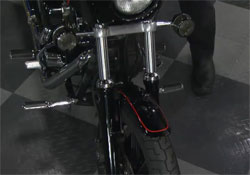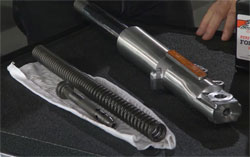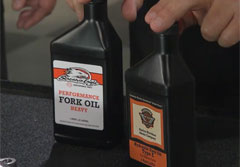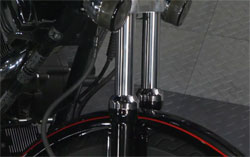Fork Maintenance
 This time, we’re going to talk about a really neglected part of most motorcycles, and that is the front forks. And here to give us some pointes: Lyndon Abel, General Manager of Patriot Harley Davidson in Fairfax, Virginia. Lyndon, welcome back.
This time, we’re going to talk about a really neglected part of most motorcycles, and that is the front forks. And here to give us some pointes: Lyndon Abel, General Manager of Patriot Harley Davidson in Fairfax, Virginia. Lyndon, welcome back.
LYNDON ABEL: Thanks, Pat.
PAT GOSS: Alright, now, the forks on the front of a motorcycle. They’re a little bit more complex than we think. What do they do?
LYNDON ABEL: Absolutely. The front fork is basically your front shock absorber. So, much like the rear shock absorber, it both suspends the bike on top of the front wheel, allows the front wheel to move up and down; but also controls that movement, because otherwise it would just be a pogo stick bouncing down the road. It is, as you say, much overlooked because, like a lot of parts that are out of site, they’re often out of mind.
So essentially, this fork tube is sliding up and down inside this lower leg; suspended with a spring, controlled by fork oil. It not only lubricates all the parts, but also, as it flows through the holes in the damper rod, that controls the movement up and down.
 So here we have the components separated a little bit: this is the damper rod and fork spring, something you don’t get a chance to see very often. And here we have this thing pulled apart, with the lower leg and this fork seal. This fork seal resides in this lower leg, and as this is sliding up and down, the dirt and debris that can catch here, as well as moisture, can not only abrade the fork seal, as they do go through it. I mean it keeps most of that stuff out, but some of it does make its way through. It not only abrades that fork seal, but also does transfer into the fork oil. And while a lot of people seem to think that this is a “sealed” system, and therefore doesn’t need to be lubricated, you and I have both seen fork oil coming out the other end after a couple years, or maybe ten or twenty thousand miles, and it doesn’t look that clean.
So here we have the components separated a little bit: this is the damper rod and fork spring, something you don’t get a chance to see very often. And here we have this thing pulled apart, with the lower leg and this fork seal. This fork seal resides in this lower leg, and as this is sliding up and down, the dirt and debris that can catch here, as well as moisture, can not only abrade the fork seal, as they do go through it. I mean it keeps most of that stuff out, but some of it does make its way through. It not only abrades that fork seal, but also does transfer into the fork oil. And while a lot of people seem to think that this is a “sealed” system, and therefore doesn’t need to be lubricated, you and I have both seen fork oil coming out the other end after a couple years, or maybe ten or twenty thousand miles, and it doesn’t look that clean.
PAT GOSS: And yea, that’s for darn sure. So another thing that would make sense here is to keep the tubes clean.
LYNDON ABEL: Absolutely. One of the great tips, if you have a front end like this, is to take some lubricant; WD-40 works just fine; clean these fork legs nicely; then grab your brake, and push the front end up and down a few times, you’ll see some dirt sort of collect in a ring. Wipe that off. If you do that every couple of months, you’ll really extend the life of your fork seals.
PAT GOSS: Okay. And always make sure you use the proper oil.
 LYNDON ABEL: Use the proper oil. The oil, not only does it have to be compatible with the seals, of course, but also viscosity is very important. You want to use what’s recommended, often times you’ll have two or three choices. Heavier oil will make a stiffer front end, and the reverse for lighter oil.
LYNDON ABEL: Use the proper oil. The oil, not only does it have to be compatible with the seals, of course, but also viscosity is very important. You want to use what’s recommended, often times you’ll have two or three choices. Heavier oil will make a stiffer front end, and the reverse for lighter oil.
PAT GOSS: Two years, or twenty thousand?
LYNDON ABEL: Check your owner’s manual. Some are ten. Some are thirty.
PAT GOSS: Okay. Lyndon, thank you.
LYNDON ABEL: Thank you, Pat.
PAT GOSS: And if you have a question or comment, drop me a line. Right here, at MotorWeek.






